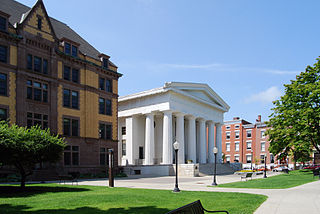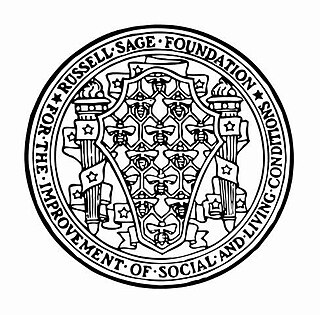A nation is a stable community of people formed on the basis of a common language, territory, history, ethnicity, or a common culture. A nation is more overtly political than an ethnic group; it has been described as "a fully mobilized or institutionalized ethnic group". Some nations are equated with ethnic groups and some are equated with an affiliation with a social and political constitution. A nation has also been defined as a cultural-political community that has become conscious of its autonomy, unity and particular interests. In international law nation is the term for a sovereign state.

The greater sage-grouse, also known as the sagehen, is the largest grouse in North America. Its range is sagebrush country in the western United States and southern Alberta and Saskatchewan, Canada. It was known as simply the sage grouse until the Gunnison sage-grouse was recognized as a separate species in 2000. The Mono Basin population of sage grouse may also be distinct.

Salvia officinalis is a perennial, evergreen subshrub, with woody stems, grayish leaves, and blue to purplish flowers. It is a member of the mint family Lamiaceae and native to the Mediterranean region, though it has been naturalized in many places throughout the world. It has a long history of medicinal and culinary use, and in modern times it has been used as an ornamental garden plant. The common name "sage" is also used for a number of related and unrelated species.
The term "person of color" is primarily used to describe any person who is not considered white. In its current meaning, the term originated in, and is primarily associated with, the United States; however since the 2010s it has been adopted elsewhere in the Anglosphere, including relatively limited usage in the United Kingdom, Canada, Australia, Ireland, South Africa, and Singapore.

The ecology of California can be understood by dividing the state into a number of ecoregions, which contain distinct ecological communities of plants and animals in a contiguous region. The ecoregions of California can be grouped into four major groups: desert ecoregions, Mediterranean ecoregions, forested mountains, and coastal forests.
Sage or SAGE may refer to:
Jewish leadership has evolved over time. Since the destruction of the Second Temple in Jerusalem in 70 CE, there has been no single body that has a leadership position over the entire Jewish diaspora. Various branches of Judaism, as well as Jewish religious or secular communities and political movements around the world elect or appoint their governing bodies, often subdivided by country or region.

Russell Sage College is a co-educational college with two campuses located in Albany and Troy, New York, approximately 150 miles (240 km) north of New York City in the Capital District. Russell Sage College offers both undergraduate and graduate degree and certificate programs. As of 2020, roughly 1300 undergraduate students and 1200 graduate students are in enrolled.

The Russell Sage Foundation is an American non-profit organisation established by Margaret Olivia Sage in 1907 for “the improvement of social and living conditions in the United States.” It was named after her recently deceased husband, railroad executive Russell Sage. The foundation dedicates itself to strengthening the methods, data, and theoretical core of the social sciences in order to better understand societal problems and develop informed responses. It supports visiting scholars in residence and publishes books and a journal under its own imprint. It also funds researchers at other institutions and supports programs intended to develop new generations of social scientists. The foundation focuses on labor markets, immigration and ethnicity, and social inequality in the United States, as well as behavioral economics.
Urban studies is based on the study of the urban development of cities. This includes studying the history of city development from an architectural point of view, to the impact of urban design on community development efforts. The core theoretical and methodological concerns of the urban studies field come from the social science disciplines of history, economics, sociology, geography, political science, anthropology, and the professional fields of urban planning, architecture, landscape architecture, and urban design. Urban studies helps with the understanding of human values, development, and the interactions they have with their physical environment. The field originated primarily from the United Kingdom and the United States, and has spread to research how international cities apply this research.

Community Change, formerly the Center for Community Change (CCC), is a progressive community organizing group active in the United States. It was founded in 1968 in response to civil rights concerns of the 1960s and to honor Robert F. Kennedy. The organization's stated mission is "to build the power and capacity of low-income people, especially low-income people of color, to change their communities and public policies for the better." Community Change has received funding from the Democracy Alliance and the Tides Advocacy Fund.

Phi Sigma Nu (ΦΣΝ) is the oldest and largest Native American fraternity in the United States. It was founded in 1996 in North Carolina.

Lesage is a census-designated place (CDP) on Ohio River Road in Cabell County, West Virginia, United States. As of the 2010 census, its population was 1,358. It is the nearest community to Clover Site, a National Historic Landmark.

The Motte Rimrock Reserve, a unit of the University of California Natural Reserve System affiliated with the University of California, Riverside, is an ecological reserve and biological field station located on a small plateau overlooking the Perris Valley in west-central Riverside County, California, United States.

Russell is an unincorporated community in Lake County, Illinois, United States. The community is located on Russell Road, a few miles east of Interstate 94, and was named for industrialist and political figure Russell Sage, who was connected with the Chicago, Milwaukee, St. Paul and Pacific Railroad which bisects the village. Russell is near the Wisconsin state line 5 miles (8.0 km) west of Winthrop Harbor. Russell has a post office with ZIP code 60075.

Hanna City Air Force Station is a closed United States Air Force General Surveillance Radar station. It is located 1.6 miles (2.6 km) west-northwest of Hanna City, Illinois. It was closed in 1968. It is still in use by the Federal Aviation Administration as a Joint Surveillance System radar station.

Topsham Air Force Station is a closed United States Air Force station. It is located 2.1 miles (3.4 km) north of Brunswick, Maine. It was closed in 1969.

Fort Lee Air Force Station is a closed United States Air Force station. It is located 2.9 miles (4.7 km) northwest of Prince George, Virginia. It was closed in 1983.

The 4620th Air Defense Wing is a discontinued wing of the United States Air Force. Its last assignment was with Air Defense Command (ADC) at Santa Monica, California, where it was discontinued in 1961. The wing was organized in 1955 to ensure that the Semi-Automatic Ground Environment (SAGE) air defense system, was compatible with ADC's operational requirements. It also performed operational testing and training on SAGE and earlier systems. Once SAGE started to become operational, the need for the wing no longer existed and it was discontinued, although one of its subordinate groups continued the SAGE training mission until 1962.

Hutchinson Air Force Station is a closed United States Air Force station. It is located 2 miles (3.2 km) west-southwest of Yoder, Kansas. It was closed for all military use in 1968. It was operated alongside Hutchinson Air National Guard Base when it was operational.
















